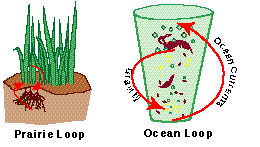
Diatoms are plants, and like all plants they bloom when they have water,
sunlight, and a supply of plant food. Near the South Pole, sunlight is not
a problem because there are 24 hours of daylight - in the summer.
"Plant food? Plants don't eat food," says the young listener.
"They make food."
"Ah, you are so right," gleams the storyteller, "Plant food" is really made of minerals and elements like phosphate and phosporous, and like nitrate and nitrogen. These are called nutrients.
When diatoms have all three things... water, sunlight, and nutrients, they start splitting and they split, split, split, making a gooy, brownish bloom which floats on the water and feeds the krill, which are then scooped up by the Blue Whale.
So I can truly say......
The Blue Whale is the biggest animal that ever lived in the world because the ocean water near Antarctica is loaded with nutrients."
The answer to a question about where nutrients come from can be found
on the grassy prairie of Nebraska, or almost anywhere. Nutrients don't come
from anywhere. They just go around and around. Grass which grows on the
prairie sucks up its nutrients, like phosphorous, potassium, and nitrogen,
from the soil. When the leaves of grass get brown and die, they collect
on the surface, they get buried by dust and dirt, and they decay as they
are eaten by microscopic bacteria. The decay returns the nutrients to the
soil and, once again, phosporous and nitrogen are sucked up by the roots
to help make more green leaves. Farmers and biologists call this the nutrient
cycle, or nutrient loop.

The nutrient loop is found everywhere there is life on earth. In the
ocean near Antarctica, the nutrients are used by diatoms and eaten by krill.
When diatoms are eaten by krill, and when krill are eaten by whales, the
waste (fecal matter) falls through the water and decays as it is eaten by
bacteria. By the time it decays it is deep in the ocean and is carried away
by an ocean current. Some time later, and in some places, the deep ocean
water comes back up into the surface and into the sunlight, where the diatoms
are waiting.
Previous Page.......................Next Page